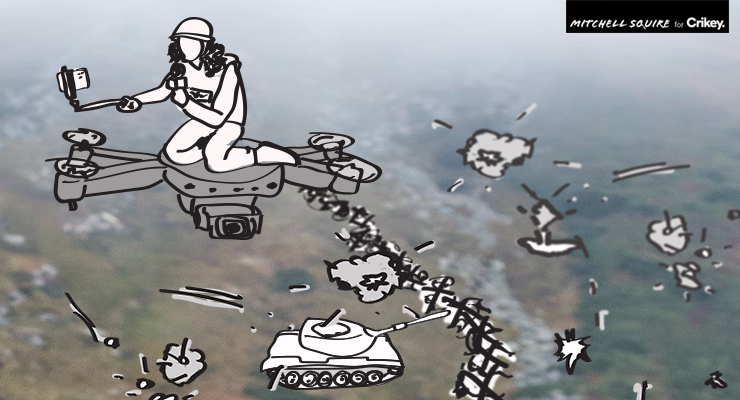
Ukraine has already been tagged the TikTok war. That’s too narrow: it’s Instagram, YouTube and Twitter as well. It’s a high-tech weapons war fought on, and fought with, the matching digital sophistication of social media. It has cut out the journalistic middle, that once-venerated war correspondent — reporter, photographer, camera operator — we trusted to be our eyes on the ground.
It’s powered the agency of people on the ground with a real-time challenge to the “Westsplaining” complacency of talking heads on both left and right eager to jimmy the war into some 19th-century idea of great power competition.
We’ve long believed that in war, truth becomes the first casualty (thanks for the tip, Aeschylus). Maybe no longer, but that means we need to work much harder to know what we can trust and believe.
Inevitably, the medium becomes the message. Video-based platforms like TikTok, Reels and YouTube enable Ukraine’s tech-literate rising generation to broadcast messages that algorithms help proliferate, rewarding the flair, wit and action that video demands.
To retain their relevance, journalists on the ground mesh social media with their still-unique offering of trust and scale, jumping in to embrace what social media delivers while filtering journalistically for accuracy and relevance.
But they can’t compete on access. As the Kyiv Independent’s defense reporter Illia Ponomarenko tweeted to his 850,000-odd followers on the weekend:
In many ways, this war is unique. It’s carried out in a territory with 40 million people having a camera in the pocket. Every single move is being reported online. Everyone’s in the open. You just can’t hide anything. Good luck waging a war of occupation in this environment.
It’s already powering the Ukrainians’ war strategy of both see and be seen. Once, if journalists weren’t there, certain things may as well not have happened. Now, amplifying the views of ordinary people with the power of The New York Times — in, say, occupied Kherson — shatters the fake news of Russia’s “liberation” of Ukraine.
The country’s TV-trained president, Volodymyr Zelenskyy, has learnt quickly, reshaping his grabs for the TikTok age.
Outside the country, social media coverage is peeling back increasing layers of complexity. As Crikey wrote last week, open source intelligence, such as publicly available satellite imagery, cuts through the traditional fog of war. On Thursday, Tyre Twitter, of all things, exploded with a discussion about the impact on the invasion of poor tire-maintenance practices on Russian trucks.
It’s chilling when war meets social media in the form of video feeds from combat drones, with a bird’s-eye view of attacks on Russian forces. Sanitised as it may be by the grainy, soundless, black-and-white footage, these are real people dying in our feeds.
We’re still working out just what “truth is the first casualty” means in the social media age. It’s no longer the case that the truth just isn’t out there, or that it’s only available pre-glossed with propaganda. It’s that there’s too much information. It’s too easy to lose sight of what matters in a sea of misinformation, disinformation and manipulation. Social media prioritises attention over truth, the micro over the macro, the new over the repetitive, a tank-stealing farmer video over the relentless, grinding, night-time bombing of Kharkiv.
Sometimes truth ends up sorted out in the give-and-take on social media, with real-time challenges and corrections from journalists and analysts. Fact-checkers like Bellingcat review what they can, although their primary focus is on deliberate misinformation by Russia and banking posts for war crimes monitoring. Big US media, such as The Washington Post, bring their technological clout to the ocean of online video.
Harvard’s Shorenstein Center has highlighted media manipulation through “recontextualised media” — the use of an image, video or audio clip posted in a different or false context than it was originally taken.
Meanwhile, in Russia, we’re seeing the old-school approach to wartime media management: a combination of fake news (Nazis in Ukraine!), a ban on US social media platforms, and significantly toughened restrictions on reporting (including describing the war in Ukraine as, well, a “war”).
The largely state-controlled broadcast media where most Russians get their news has gone along, turning the invasion into “the war that Russians do not see.” Most independent media have shut up shop while global media is pulling its reporters out of Russia for their personal safety.








Interesting overview and related, is how many commentators in media stating that SM is one of Putin’s assets i.e. the significant number of non city/urban Russians who, like their counterparts in Australia, keep to locally curated legacy media in their own language and no meaningful foreign content.
However, like we hear stories emerging of Russians in Ukraine etc. trying to explain what’s happening on the ground to their elderly parents and relatives, i.e. not what they are being told; slowly moving from ignorance through denial; next part is the challenge for Putin’s regime.
Like Australia, many people in regions now have smartphones, then add networks of trusted friends/family sharing images/info from elsewhere (though often illegal), it’s approaching the most powerful and persuasive form of communication i.e. ‘word of mouth’ but takes time to get legs (it’s the objective of advertising).
What comes if the denial phase is breached, pensioner protests?
The main problem with the seemingly apparent merging of Main Stream Media and Social Media reporting on the Ukraine War is that we are getting horrific pictures and stories, (which for any war are real – not just this one).
The secondary issue is that this has further blurred the facts, enabling misinformation, and propaganda from both sides.
I also find one of the really annoying things that has popped up is the multitude of articles from “Analysts” putting their spin on what they believe is and isn’t happening. Most of these articles have been so wrong in their predictions of what’s next, and also seem to fall into the same bracket as other misinformation and propaganda.
War is a horrible thing, as the ones that are hurt the most are always the civilians that are killed, injured or displaced.
It is a shame that Diplomacy often fails as some Countries don’t negotiate in faith, or even if it seems they do, they then renege on agreements reached.
What is also not helpful is the interference by other Countries, or bodies of Countries – EU, NATO, etc.), in a localized War.
It’s like a fight between two boys in a schoolyard escalating into an all in brawl with all of the boys at the school.